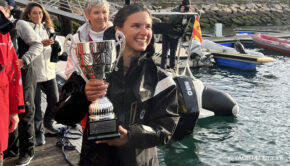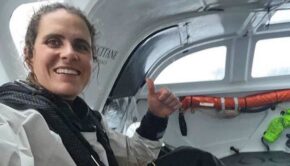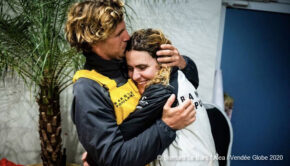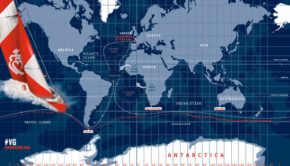Building the legend of the Vendée Globe
Published on December 11th, 2018
The Vendée Globe is still the only non-stop solo round the world race without assistance. Held every four years, the ninth edition in 2020-21 will set sail on November 8 from les Sables d’Olonne, France.
For an Anglo, it is hard to fathom France’s massive immense attraction of the race. Popularity for the 2016-17 race continued to grow, with the village seeing 2,250,000 visitors and the media coverage setting new records, with each French person reached 74 times on the various media throughout the race.
With a limit of 30 skippers, crowds welcome home each and every finisher. Some for victory. Some for the adventure they conquered. Some for the message they shared. But most dearly embraced is when the human spirit overcame adversity. This is the legend of the race.
On March 16, 2001 the quaysides and coasts of Les Sables d’Olonne are swarming with thousands of people out to welcome a hero home. But Michel Desjoyeaux, the winner, arrived more than one month ago. The solo racer that the crowds have come out to see come home is Yves Parlier whose story remains one of the most remarkable in the Vendée Globe’s long history.
Parlier was in the match to win when he was dismasted in the east of the Indian Ocean. Instead of giving up he headed to Stewart Island to the south of New Zealand with the objective of rebuilding his mast and re-stepping it without any outside assistance. The remarkable repair takes him two weeks.
During that time he constructs a rudimentary oven to cure his carbon composite repair. In the meantime he is low on food and so catches fish and cooks up seaweed to eat. He steps and re-rigs his mast and sails to the finish where Parlier takes 13th but completes a truly inspirational adventure worthy of the huge welcome he was given.
Parlier’s adventure remains unique, but others have triumphed over the adversity of dismasting.
In 1992, Philippe Poupon was about to finish second behind Alain Gautier and had just recrossed the equator on his way home when his rig crashed down. Poupon set a jury rig and only narrowly missed second to the redoubtable Jean-Luc Van Den Heede, but still made third.
In 2000, Catherine Chabaud was about to complete her second Vendée Globe when she disamsted off the Portuguese coast. She tries to build herself a makeshift rig to get to the line but her team tells her, “Catherine, it’s ten days of winds on the nose for you, it’s a wasted effort.” Disappointed, she routes to Portugal and finishes hors concours officially unplaced.
The most spectacular recent endeavor was that of young Kiwi skipper Conrad Colman who dismasted in what would have been his last big storm enroute to a probable placing inside the top ten towards the end of the 2016-17 race.
Colman was at the latitude of Porto and the Azores when his rig came down. Initially, he had to ride out the remnants of the storm before he could finally set a jury rig with his boom, a piece of mainsail, and storm jib. Against the wind for the first few days, he made little progress until the wind shifted to free him and reach to the finish line and a huge welcome.
Three intrepid solo racers have finished into Les Sables d’Olonne without a keel, each having sailed further than their predecessor.
In 2005, it was Mike Golding who took third place after sailing the last 50 or so miles with no keel. He realized something was wrong immediately, dropped his sails and filled the ballast tanks of his IMOCA. He sailed under reduced canvas and broke the finish line during the night, some 24 hours after Jean Le Cam who took second. At that time no one imagined such a feat was possible, but fully ballasted, the IMOCA 60 is relatively stable.
Then in 2009 it was Marc Guillemot who was challenging for the podium in that epic 2008-9 race during which he had stood by the injured Yann Eliès in the southern ocean. Guillemot’s keel had been giving cause for concern before the stub dropped off at some 900 miles from the finish.
A renowned multihull racer, Guillemot wraps the mainsheet around his wrist as he sleeps as an alarm in case he is suddenly overpowered. Guillemot crosses fourth but receives a time compensation as redress for standing by Eliès and so is promoted to third.
Finally Jean-Pierre Dick, during the Vendée Globe 2012-2013, sailed 2750 miles with no keel. He has to attack those miles in two stages. He has to stop in to northern Spain to let a big storm pass him, and during these four days stopped, loses third to the British skipper Alex Thomson.
Stuck on board, true to the race rules, JP Dick can see the local Spanish fishermen – similarly stormbound – drinking beers and eating tapas at the quayside bars while he is trying to ration his final packets of freeze dried foods to last him to the finish. It is his final torture before crossing the finish at the famous Nouch Sud buoy and taking the Les Sables d’Olonne channel.
Source: www.vendeeglobe.org/en









 We’ll keep your information safe.
We’ll keep your information safe.